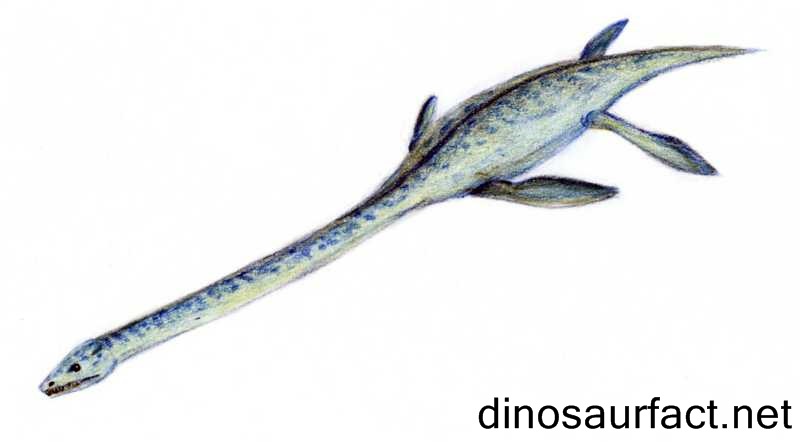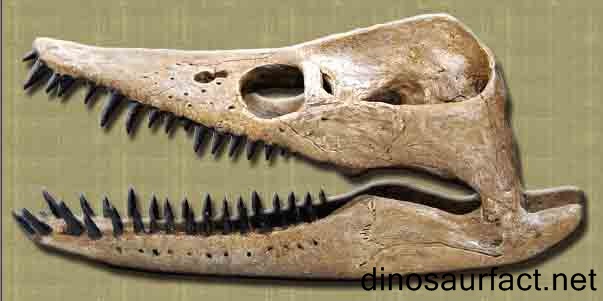 Click to visit the previous Marine Specie bio
Click to visit the previous Marine Specie bio
 |
|
 |
|
Kingdom: Animalia
Phylum: Chordata
Class: Reptilia
SuperOrder: Sauropterygia
Order: Plesiosauria
SubOrder: comingsoon
Family: Elasmosauridae
Genus: Libonectes
 |
|
 |
|
 |
|

The Libonectes was a large plesiosaur that existed during the late Cretaceous period. Its length was estimated to be around 30 to 35 feet. The exact weight of the Libonectes is unknown as only a few of its bones have yet been uncovered. But by extrapolating data from other plesiosaurs, its weight is judged to be about 1 to 2 tons.
The time period of the existence of the Libonectes is determined to be about 90 to 80 million years ago. This lies between the Turonian and Campanian ages of the Cretaceous period. Much of the marine fauna during this period got extinct at the Cenomanian-Turonian axenic event. This phenomenon is believed to have occurred due to oceanic volcanic activity. Most of the pliosaurs, ichthyosaurs and Spinosaurus were exterminated during the course of this event. Paleontologists theorize that the Libonectes became extinct due this cataclysmic happening.
The Libonectes was probably a meat eating vertebrate like the rest of the plesiosaurs. But omnivorous feeding habits are also plausible for this creature.
When the fossils of the Libonectes were first discovered, they were grouped as a sub species of the Elasmosaurus. But on closer examination, it was found that there were certain differences between the nasal bones of the two organisms. They were assigned a separate genus in the year 1997.
Discovery of fossils
- The remains of the Libonectes were excavated in the Britton Formation in the United States of America in 1948. This lies in the state of Texas. They were found by Charles Gill Morgan. As Texas is surrounded by water on two sides, it is not surprising that a marine organism was discovered here.
- These remains were handed over to paleontologist Samuel Welles. He determined that the belonged to the Elasmosaurus.
- No other bones of the Libonectes apart from the holotype have yet been discovered.
- A few bones of the pectoral girdle and the upper arm were initially attributed to the Libonectes buy were later deemed as unclassified.
Nature of fossils
- The fossils discovered in Texas comprised of a well preserved skull. This skull is in better condition than most other elasmosaurid skulls. A few cervical vertebrae were also included in the holotype.
- The skull was small in size with wide set orbits and nasal openings.
- The vertebrae had long neural spines and transverse processes.
- A round piece of stone was also found along with the fossils. Scientists believe that the Libonectes ingested this stone to aid maceration of its food.
Nomenclature
The prefix 'libo' has Greek origins and translates to 'southern' in English. The suffix 'nectes' is also a Greek word and means 'swimmer'. Thus the name 'Libonectes' denotes 'a southern swimmer'. As the Libonectes was a marine reptile and its fossils were discovered in the southern region of North America, such a name was chosen for it.
The binomial name Libonectes morgani was selected to honor C. G. Morgan, the finder of the Libonectes fossils.
The generic name was coined by Ken Carpenter and the species was suggested by Samuel P. Welles.
Classification
The Libonectes is classified under superorder Sauropterygia, order Pleiosauria and family Elasmosauridae.
Due to the scarcity of fossils, it was understandable that the Libonectes was confused with the Elasmosaurus. Both these reptiles were very similar physically and even today, only a handful of elasmosaurids are defined.
Samuel Welles and Ken Carpenter
- Samuel Paul Welles was an American vertebrate paleontologist. He was instrumental in defining the theropod dinosaur Dilophosaurus. He has worked extensively even in New Zealand and has helped describe the ichthyosaur Shonisaurus.
- Kenneth Carpenter is a contemporary American paleontologist. He was born in Tokyo, Japan.
He is credited with describing the dinosaur Gojirasaurus.
Carpenter's primary field of interest is stegosaurs and Ankylosaurus.
Physical characteristics
- The Libonectes was one the largest marine reptiles of the Cretaceous period. It attained an adult size of about 10 to 13 meters. It mass is thought to be about 1000 to 1800 kilos.
- The head of the Libonectes was small and its neck was muscular. This makes it improbable for the Libonectes to have a flexible neck like a snake. Many artists portray elasmosaurids with elastic and entangled necks, which is incorrect.
- The Libonectes had sharp and spaced out teeth. These were ideal for crushing mollusks and capturing cephalopods.
- The forelegs and hind legs of the Libonectes were modified to form paddles.
- The thorax and abdomen of the Libonectes was fairly rectangular and these compartments lacked a clear demarcation.
- The Libonectes most likely had small tail similar to other plesiosaurs.
Habits and habitat
The dental layout of the Libonectes indicated that it had carnivorous feeding habits. But the gastroliths found inside its skeleton leave the option of an omnivorous lifestyle open for the Libonectes.
The gastroliths also indicate that the Libonectes swallowed its prey whole and did not tear it apart. If its neck was indeed inflexible, ripping chunks from its catch would have been very difficult to achieve.
Some scientists posit that marine reptiles ingested stones to aid themselves to sink in water. But this theory is not widely accepted.
The Libonectes was a slow swimmer and relied on its size to trap its prey.
The dimensions of the Libonectes make it less likely for it to have resided in shallow waters.
Related and coexisting species
Since the fossils of the Libonectes were once classified under the genus Elasmosarus, it can be inferred that the species were related. There many similarities between the bones of the Libonectes and the Thalassomedon, indicating that they were related.
The Libonectes shared it environment marine invertebrates and ichthyosaurs such as the Platypterygius and pliosaurs such as the Brachauchenius.
Concluding notes on the Libonectes
The Libonectes was a massive marine reptile which formed an important part of the Pacific and Atlantic oceans.
As only a few bones are attributed to the Libonectes today, deducing information about its size, feeding habits and reproductive functions has been challenging for paleontologists. Most of the facts about the Libonectes are derived from data available about other elasmosaurids. But its skull was found in pristine condition and has been used as a template to draw information about other elasmosaurid skulls.
The evolution and eventual extinction of the organisms like the Libonectes has been a topic of interest for marine biologists ever since their discovery.
Index
Extinct Profiles
 Triassic Dinosaurs
Triassic Dinosaurs Jurassic Dinosaurs
Jurassic Dinosaurs Cretaceous Dinosaurs
Cretaceous Dinosaurs Pterosaurs
Pterosaurs Marine Reptiles
Marine Reptiles Dinosaur Extinction
Dinosaur Extinction